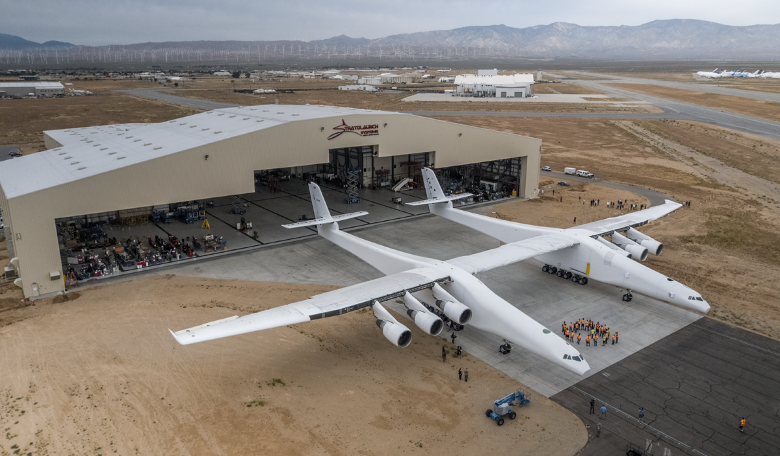Rolling quietly out of the hangar, without the fanfare typically attached to such events, the Stratolaunch airplane – the world’s largest aircraft by wingspan and the largest all-composite plane ever built – made its debut last week in the Mojave desert.
Stratolaunch, an aircraft to dwarf all others, is the vision of Paul G. Allen, the Microsoft co-founder and Seattle Seahawks owner who has developed the craft with a purpose to launch rockets directly into orbit from an altitude of 9,100 metres (30,000 feet).
By constructing an airplane-style craft rather than a traditional rocket launcher, the twin-hulled behemoth aircraft, with its 28 wheels and six Boeing 747 engines, can be re-used over and over again and without a fixed platform in which to launch from, it can avoid hazards such as airborne traffic and cancelations due to bad weather.
Stratolaunch was built by Scaled Composites, a Mojave-based aerospace company founded by Burt Rutan, Scaled Composites is also the company that built SpaceShipOne and White Knight Two – an aircraft that has been acquired by Virgin Galactic to add to their fleet of suborbital spaceplanes.
The aircraft has now been moved out of its hangar for the first time ever to conduct aircraft fuelling tests, thus marking the beginning of the aircraft ground and flight testing phase.
"Over the coming weeks and months, we'll be actively conducting ground and flight-line testing at the Mojave Air and Space Port," said Stratolaunch Systems Corp. CEO Jean Floyd in a statement last week. "This is a first-of-its-kind aircraft, so we're going to be diligent throughout testing and continue to prioritize the safety of our pilots, crew and staff. Stratolaunch is on track to perform its first launch demonstration as early as 2019."
The Stratolaunch aircraft weighs a staggering 226796 kilograms (500,000 lbs), but with a wingspan longer than a National Football League field and measuring 72.5 metres (238 feet) from nose to tail and standing 15 metres (50 foot) tall from the ground to the top of the vertical tail, it is perhaps to be expected.
“The Stratolaunch aircraft is designed for a max takeoff weight of 1,300,000 lbs., meaning it’s capable of carrying payloads up to approximately 550,000 lbs.,” said Ford. “As we announced last fall, we will initially launch a single Orbital ATK Pegasus XL vehicle with the capability to launch up to three Pegasus vehicles in a single sortie mission. We have already started preparations for launch vehicle delivery to our Mojave facilities. We’re actively exploring a broad spectrum of launch vehicles that will enable us to provide more flexibility to customers.”











